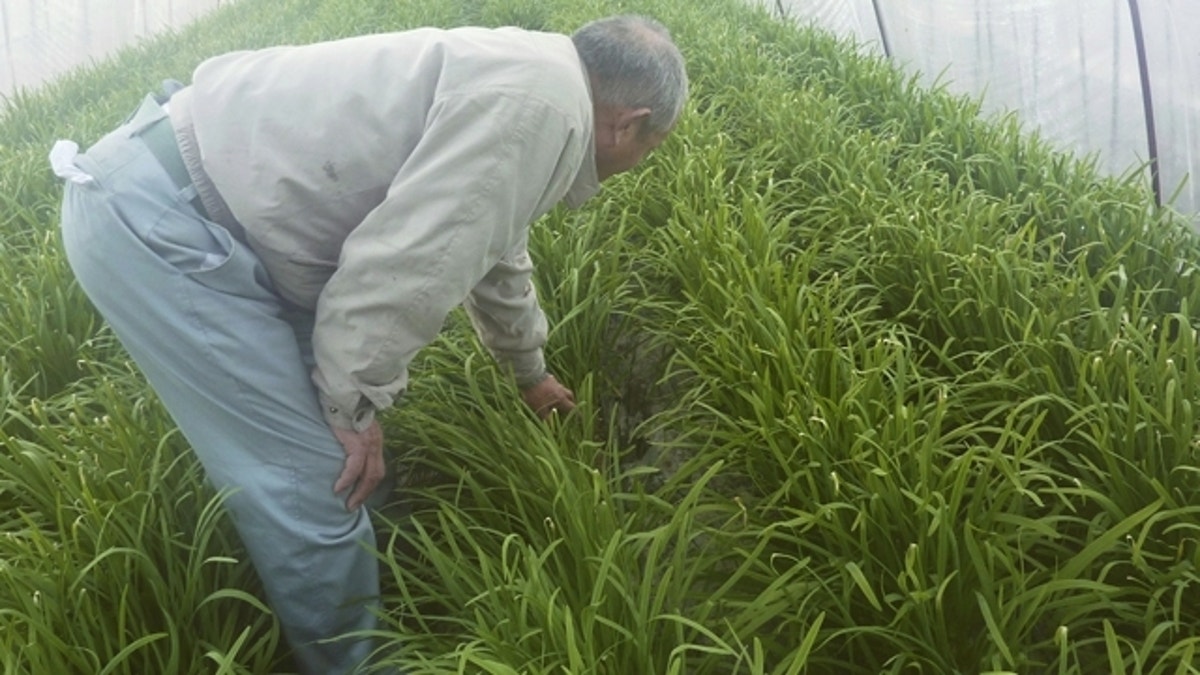
In this Thursday, March 18, 2011 photo, a farmer checks leeks cultivated in a vinyl house in the earthquake and tsunami-stricken town of Yamamoto in Miyagi Prefecture, northeastern Japan. Japan said Saturday, March 19, that radiation levels in spinach and milk from farms near its tsunami-stricken Fukushima Dai-ichi nuclear power complex exceeded government safety limits
FUKUSHIMA, Japan – Pressure levels are rising again in a reactor at Japan's damaged Fukushima Dai-ichi nuclear power plant, an official from the country's nuclear safety agency said Saturday.
The recent setback means that operators will have to vent more radioactive gas into the environment.
Safety agency official Hidehiko Nishiyama said Sunday that efforts to put water in the Unit 3 reactor at the Fukushima Dai-ichi complex might not have been working.
He says the plant operator will release some radioactive gas from the reactor into the environment and that this may slow work on restoring power and cooling systems to the unit.
Nishiyama says that means radiation levels around the plant will rise again. The possibility of increased radiation levels could further concerns for contaminated food and water, which has already been found in areas around the plant.
A government ministry reported Saturday that small amounts of the iodine was found in tap water in Tokyo and five other prefectures. The ministry says the amounts did not exceed government safety limits but usual tests show no iodine.
Earlier Saturday, Japan reported elevated radiation levels in spinach and milk from farms near its tsunami-crippled nuclear complex, as emergency teams scrambled Saturday to restore power to the plant so it could cool dangerously overheated fuel.
Firefighters also pumped tons of water directly from the ocean into one of the most troubled areas of the Fukushima Dai-ichi nuclear complex, the cooling pool for used fuel rods at the plant's Unit 3, which are at risk of burning up and sending a broad release of radioactive material into the environment.
The first word on contaminated food in the crisis came as Japan continued to grapple with overwhelming consequences of the cascade of disasters unleashed by a 9.0-magnitude earthquake on March 11. The quake spawned a tsunami that ravaged Japan's northeast coast, killing more than 7,700 people, and knocked out backup cooling systems at the nuclear plant.
Just outside the bustling disaster response center in the city of Fukushima, 40 miles (60 kilometers) northwest of the plant, government nuclear specialist Kazuya Konno was able to take only a three-minute break for his first meeting with his wife Junko and their children since the quake.
"It's very nerve-wracking. We really don't know what is going to become of our city," said Junko Konno, 35. "Like most other people we have been staying indoors unless we have to go out."
She brought her husband a small backpack with a change of clothes and snacks. The girls -- aged 4 and 6 and wearing pink surgical masks decorated with Mickey Mouse -- gave their father hugs.
The tainted milk was found 20 miles from the plant while the spinach was collected between 50 miles and 65 miles to the south, Chief Cabinet Secretary Yukio Edano told reporters in Tokyo.
While the radiation levels exceeded the limits allowed by the government, Edano said the products "pose no immediate health risk" and that more testing was being done on other foods. If tests show further contamination, Edano said food shipments would be halted from the area.
"It's not like if you ate it right away you would be harmed," Edano said. "It would not be good to continue to eat it for some time."
Edano said the amount of radiation detected in the milk would as much as one CT scan if consumed continually for a year while for spinatch it would be a fifth of one CT scan. A CT scan is a compressed series of X-rays used for medical tests.
Low levels of radiation have been detected well beyond Tokyo, which is 140 miles (220 kilometers) south of the plant, but hazardous levels have been limited to the plant itself.
Nuclear reactors at the Fukushima Dai-ichi plant began overheating and leaking radiation into the atmosphere in the days after the March 11 quake and the subsequent tsunami overwhelmed its cooling systems. The government admitted it was slow to respond to the nuclear troubles, which added another crisis on top of natural disasters which left an estimated more than 10,000 dead and displaced more than 400,000 others.
The Associated Press contributed to this report.
